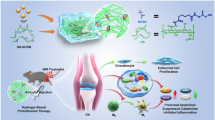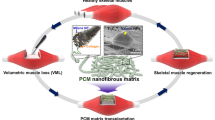Abstract
Glucosamine (GlcN) is a component of native cartilage extracellular matrix and useful in cartilage repair, but it was limited by toxicity in high concentrations. With the aim of altering bioactive properties of GlcN to reduce the toxicity and to facilitate chondrogenesis for hyaline cartilage formation, we introduced an amino-group modification with double bond into GlcN to produce N-acryloyl-glucosamine (AGA). The cell ATDC5 was chosen to evaluate its cytotoxicity and chondrogenesis capability. Cell proliferation and cytotoxicity assay showed that AGA had significantly reduced the cytotoxicity compared to GlcN, and promoted ATDC5 proliferation. Alcian blue staining and biochemical analysis indicated that AGA enhanced extracellular matrix deposition. Both the mRNA and protein levels of articular cartilage markers, like Collagen II and Aggrecan were up-regulated, as shown by quantitative real-time PCR and immunofluorescence staining. Moreover, the level of fibrocartilage marker Collagen I and hypertrophic marker Collagen Χ weren’t significantly changed. Overall, these results demonstrated that the AGA achieved the functional double-bond, reduction in toxicity and enhancement in chondrogenesis could be more potential in cartilage repair.
Graphical abstract







Similar content being viewed by others
References
Hunziker EB. Articular cartilage repair: basic science and clinical progress. A review of the current status and prospects. Osteoarthr Cartil. 2002;10:432–63.
Cutolo M, Berenbaum F, Hochberg M, Punzi L, Reginster JY. Commentary on recent therapeutic guidelines for osteoarthritis. Semin Arthritis Rheum. 2015;44:611–7.
Gallagher B, Tjoumakaris FP, Harwood MI, Good RP, Ciccotti MG, Freedman KB. Chondroprotection and the prevention of osteoarthritis progression of the knee: a systematic review of treatment agents. Am J Sports Med. 2015;43:734–44.
Hwang NS, Varghese S, Theprungsirikul P, Canver A, Elisseeff J. Enhanced chondrogenic differentiation of murine embryonic stem cells in hydrogels with glucosamine. Biomaterials. 2006;27:6015–23.
Chen YJ, Huang YS, Chen JT, Chen YH. Protective effects of glucosamine on oxidative-stress and ischemia/reperfusion-induced retinal injuryprotective effects of glucosamine on retina. Ophthalmol Vis Sci. 2015;56:1506.
Azuma K, Osaki T, Kurozumi S, Kiyose M, Tsuka T, Murahata Y, et al. Anti-inflammatory effects of orally administered glucosamine oligomer in an experimental model of inflammatory bowel disease. Carbohydr Polym. 2015;115:448–56.
Avantaggiato A, Palmieri A, Carinci F, Trapella G, Sollazzo V, Lauritano D. Effects of glucosamine and nucleotide association on fibroblast: extracellular matrix gene expression. Int J Immunopathol Pharmacol. 2014;27:689–93.
Dodge GR, Jimenez SA. Glucosamine sulfate modulates the levels of aggrecan and matrix metalloproteinase-3 synthesized by cultured human osteoarthritis articular chondrocytes. Osteoarthr Cartil. 2003;11:424–32.
Varghese S, Theprungsirikul P, Sahani S, Hwang N, Yarema KJ, Elisseeff JH. Glucosamine modulates chondrocyte proliferation, matrix synthesis, and gene expression. Osteoarthr Cartil. 2007;15:59–68.
Gouze JN, Bianchi A, Becuwe P, Dauca M, Netter P, Magdalou J, et al. Glucosamine modulates IL‐1‐induced activation of rat chondrocytes at a receptor level, and by inhibiting the NF‐κB pathway. FEBS Lett. 2002;510:166–70.
Sharma AK, Arora D, Singh LK, Gangwal A, Sajid A, Molle V, et al. Serine/threonine protein phosphatase PstP of mycobacterium tuberculosis is necessary for accurate cell division and survival of pathogen. J Biol Chem. 2016;291:24215–30.
Gilzad Kohan H, Kaur K, Jamali F. Synthesis and characterization of a new peptide prodrug of glucosamine with enhanced gut permeability. PLoS ONE 2015;10:e0126786.
Zeng L, Xu G, Gao P, Zhang M, Li H, Zhang J. Design, synthesis and evaluation of a novel class of glucosamine mimetic peptides containing 1,3-dioxane. Eur J Med Chem. 2015;93:109–20.
Atsumi T, Ikawa Y, Miwa Y, Kimata K. A chondrogenic cell line derived from a differentiating culture of AT805 teratocarcinoma cells. Cell Differ Dev. 1990;30:109–16.
Ustun S, Tombuloglu A, Kilinc M, Guler MO, Tekinay AB. Growth and differentiation of prechondrogenic cells on bioactive self-assembled peptide nanofibers. Biomacromolecules. 2013;14:17–26.
Caron MMJ, Emans PJ, Cremers A, Surtel DAM, Coolsen MME, van Rhijn LW, et al. Hypertrophic differentiation during chondrogenic differentiation of progenitor cells is stimulated by BMP-2 but suppressed by BMP-7. Osteoarthr Cartil. 2013;21:604–13.
Challa TD, Rais Y, Ornan EM. Effect of adiponectin on ATDC5 proliferation, differentiation and signaling pathways. Mol Cell Endocrinol. 2010;323:282–91.
Shukunami C, Shigeno C, Atsumi T, Ishizeki K, Suzuki F, Hiraki Y. Chondrogenic differentiation of clonal mouse embryonic cell line ATDC5 in vitro: differentiation-dependent gene expression of parathyroid hormone (PTH)/PTH-related peptide receptor. J Cell Biol. 1996;133:457–68.
Andrés-Bergós J, Tardio L, Larranaga-Vera A, Gómez R, Herrero-Beaumont G, Largo R. The increase in O-linked N-acetylglucosamine protein modification stimulates chondrogenic differentiation both in vitro and in vivo. J Biol Chem. 2012;287:33615–28.
Koshimizu T, Kawai M, Kondou H, Tachikawa K, Sakai N, Ozono K, et al. Vinculin functions as regulator of chondrogenesis. J Biol Chem. 2012;287:15760–75.
Wang Q, Ren L, Xu C, Zhai Z, Zhou J-A, Yao Y, et al. Synthesis and characterization of glucosamine modified poly(ethylene glycol) hydrogels via photopolymerization. J Appl Polym Sci. 2013;128:89–96.
Hwang NS, Varghese S, Li H, Elisseeff J. Regulation of osteogenic and chondrogenic differentiation of mesenchymal stem cells in PEG-ECM hydrogels. Cell Tissue Res. 2011;344:499–509.
Kim YJ, Sah R, Doong J, Grodzinsky AJ. Fluorometric assay of DNA in cartilage explants using Hoechst 33258. Anal Biochem. 1988;174:168–76.
Farndale RW, Buttle DJ, Barrett AJ. Improved quantitation and discrimination of sulphated glycosaminoglycans by use of dimethylmethylene blue. Biochimica et Biophysica Acta. 1986;883:173–7.
Imsoonthornruksa S, Noisa P, Parnpai R, Ketudat-Cairns M. A simple method for production and purification of soluble and biologically active recombinant human leukemia inhibitory factor (hLIF) fusion protein in Escherichia coli. J Biotechnol. 2011;151:295–302.
DeLise AM, Fischer L, Tuan RS. Cellular interactions and signaling in cartilage development. Osteoarthr Cartil. 2000;8:309–34.
Bekesi JG, Molnar Z, Winzler RJ. Inhibitory effect of d-glucosamine and other sugar analogs on the viability and transplantability of ascites tumor cells. Cancer Res. 1969;29:353–9.
Terry DE, Rees-Milton K, Smith P, Carran J, Pezeshki P, Woods C, et al. N-acylation of glucosamine modulates chondrocyte growth, proteoglycan synthesis, and gene expression. J Rheumatol. 2005;32:1775–86.
Noyszewski EA, Wroblewski K, Dodge GR, Kudchodkar S, Beers J, Sarma AVS, et al. Preferential incorporation of glucosamine into the galactosamine moieties of chondroitin sulfates in articular cartilage explants. Arthritis Rheumatol. 2001;44:1089–95.
Mroz PJ, Silbert JE. Use of 3H‐glucosamine and 35S‐sulfate with cultured human chondrocytes to determine the effect of glucosamine concentration on formation of chondroitin sulfate. Arthritis Rheumatol. 2004;50:3574–9.
McClain DA, Paterson AJ, Roos MD, Wei XP, Kudlow JE. Glucose and glucosamine regulate growth-factor gene-expression in vascular smooth-muscle cells. Proc Natl Acad Sci USA. 1992;89:8150–4.
Marshall S, Nadeau O, Yamasaki K. Dynamic actions of glucose and glucosamine on hexosamine biosynthesis in isolated adipocytes differential effects on glucosamine 6-phosphate, UDP-N-acetylglucosamine, and ATP levels. J Biol Chem. 2004;279:35313–9.
Hresko RC, Heimberg H, Chi MMY, Mueckler M. Glucosamine-induced insulin resistance in 3T3-L1 adipocytes is caused by depletion of intracellular ATP. J Biol Chem. 1998;273:20658–68.
Shikhman AR, Brinson DC, Valbracht J, Lotz MK. Differential metabolic effects of glucosamine and N-acetylglucosamine in human articular chondrocytes. Osteoarthr Cartil. 2009;17:1022–8.
Acknowledgements
The work was supported in the part by the National Natural Science Foundation of China (51273072, 51673071, 51603073), Natural Science Foundation of Guangdong Province (2016A030313509), Pearl River S&T Nova Program of Guangzhou (201710010195), Guangdong Scientific and Technological Project (2014B090907004) and Guangzhou Important Scientific and Technological Special Project (201508020123). Dr. Wang acknowledges financial support from Ministry of Education Tier 1 Academic Research Fund (RG30/15 to Dong-An Wang). The authors thank the grant project of South China University of Technology for PhD student short term study abroad (outside mainland).
Author information
Authors and Affiliations
Corresponding authors
Ethics declarations
Conflict of interest
The authors declare that they have no competing interests.
Rights and permissions
About this article
Cite this article
Yao, H., Xue, J., Xie, R. et al. A novel glucosamine derivative with low cytotoxicity enhances chondrogenic differentiation of ATDC5. J Mater Sci: Mater Med 28, 170 (2017). https://doi.org/10.1007/s10856-017-5971-y
Received:
Accepted:
Published:
DOI: https://doi.org/10.1007/s10856-017-5971-y




